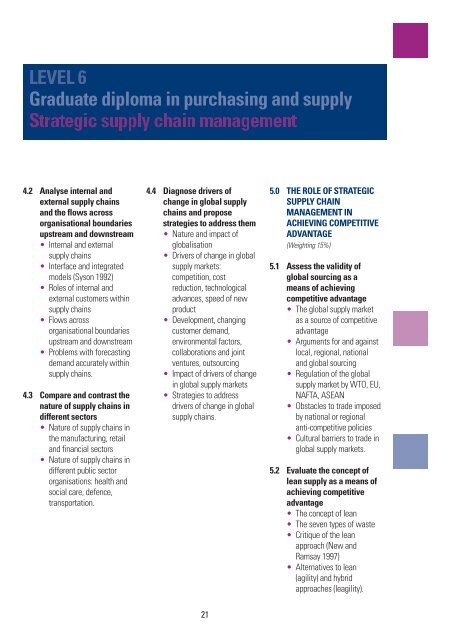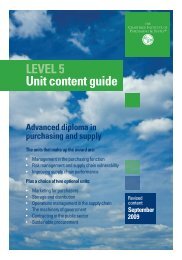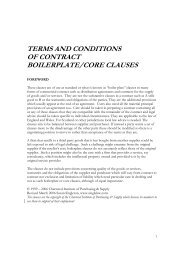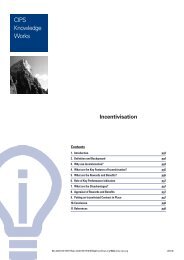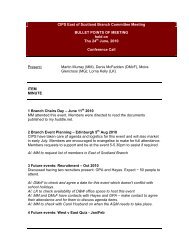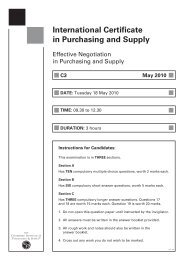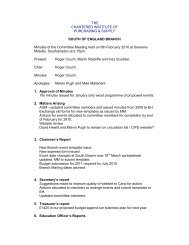Graduate diploma - The Chartered Institute of Purchasing and Supply
Graduate diploma - The Chartered Institute of Purchasing and Supply
Graduate diploma - The Chartered Institute of Purchasing and Supply
You also want an ePaper? Increase the reach of your titles
YUMPU automatically turns print PDFs into web optimized ePapers that Google loves.
4.2 Analyse internal <strong>and</strong><br />
external supply chains<br />
<strong>and</strong> the flows across<br />
organisational boundaries<br />
upstream <strong>and</strong> downstream<br />
• Internal <strong>and</strong> external<br />
supply chains<br />
• Interface <strong>and</strong> integrated<br />
models (Syson 1992)<br />
• Roles <strong>of</strong> internal <strong>and</strong><br />
external customers within<br />
supply chains<br />
• Flows across<br />
organisational boundaries<br />
upstream <strong>and</strong> downstream<br />
• Problems with forecasting<br />
dem<strong>and</strong> accurately within<br />
supply chains.<br />
4.3 Compare <strong>and</strong> contrast the<br />
nature <strong>of</strong> supply chains in<br />
different sectors<br />
• Nature <strong>of</strong> supply chains in<br />
the manufacturing, retail<br />
<strong>and</strong> financial sectors<br />
• Nature <strong>of</strong> supply chains in<br />
different public sector<br />
organisations: health <strong>and</strong><br />
social care, defence,<br />
transportation.<br />
4.4 Diagnose drivers <strong>of</strong><br />
change in global supply<br />
chains <strong>and</strong> propose<br />
strategies to address them<br />
• Nature <strong>and</strong> impact <strong>of</strong><br />
globalisation<br />
• Drivers <strong>of</strong> change in global<br />
supply markets:<br />
competition, cost<br />
reduction, technological<br />
advances, speed <strong>of</strong> new<br />
product<br />
• Development, changing<br />
customer dem<strong>and</strong>,<br />
environmental factors,<br />
collaborations <strong>and</strong> joint<br />
ventures, outsourcing<br />
• Impact <strong>of</strong> drivers <strong>of</strong> change<br />
in global supply markets<br />
• Strategies to address<br />
drivers <strong>of</strong> change in global<br />
supply chains.<br />
21<br />
5.0 THE ROLE OF STRATEGIC<br />
SUPPLY CHAIN<br />
MANAGEMENT IN<br />
ACHIEVING COMPETITIVE<br />
ADVANTAGE<br />
(Weighting 15%)<br />
5.1 Assess the validity <strong>of</strong><br />
global sourcing as a<br />
means <strong>of</strong> achieving<br />
competitive advantage<br />
• <strong>The</strong> global supply market<br />
as a source <strong>of</strong> competitive<br />
advantage<br />
• Arguments for <strong>and</strong> against<br />
local, regional, national<br />
<strong>and</strong> global sourcing<br />
• Regulation <strong>of</strong> the global<br />
supply market by WTO, EU,<br />
NAFTA, ASEAN<br />
• Obstacles to trade imposed<br />
by national or regional<br />
anti-competitive policies<br />
• Cultural barriers to trade in<br />
global supply markets.<br />
5.2 Evaluate the concept <strong>of</strong><br />
lean supply as a means <strong>of</strong><br />
achieving competitive<br />
advantage<br />
• <strong>The</strong> concept <strong>of</strong> lean<br />
• <strong>The</strong> seven types <strong>of</strong> waste<br />
• Critique <strong>of</strong> the lean<br />
approach (New <strong>and</strong><br />
Ramsay 1997)<br />
• Alternatives to lean<br />
(agility) <strong>and</strong> hybrid<br />
approaches (leagility).


